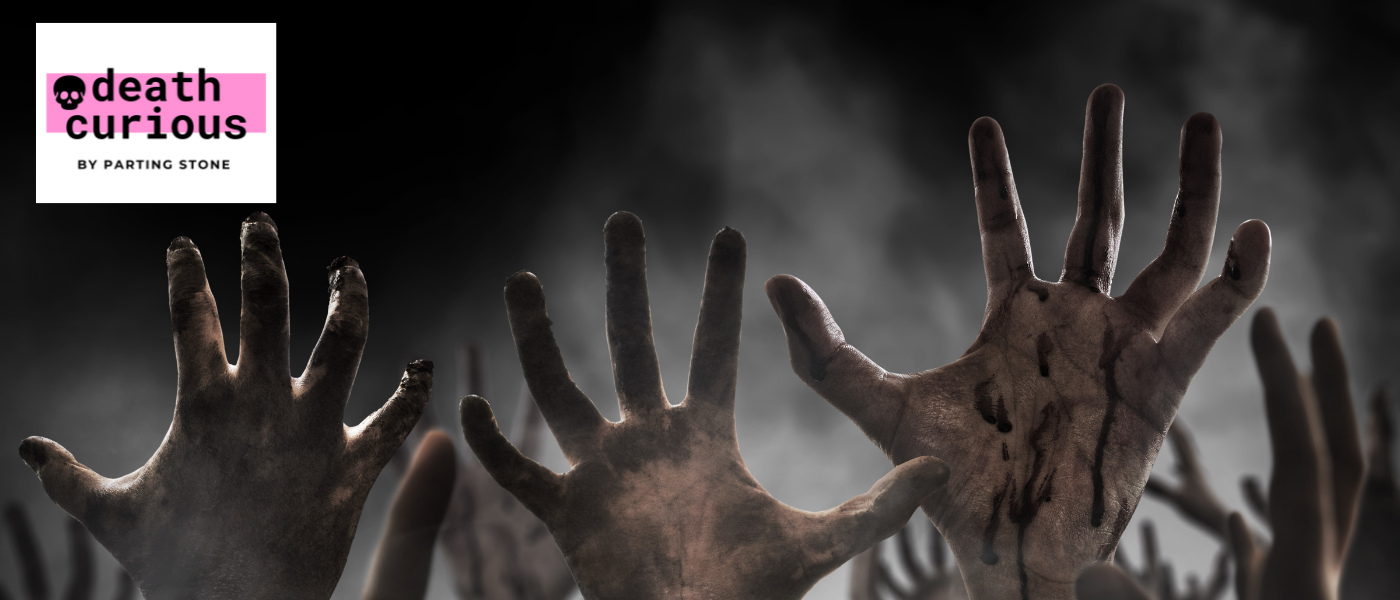Cremation Might Crush Our Apocalyptic Zombie Fantasies
This article was originally published on the Death Curious blog. Alexandra Jo and Parting Stone launched Death Curious with the mission of eliminating death avoidance and bringing people together with death-positive education.
It’s a bit of a cliché — the funeral director watching a zombie flick — but if you’re like most people, you’re intrigued by the genre. And rightfully so; horror movies, when well done, offer a safe escape from the reality of everyday concerns and let us vicariously experience terror and evil through the characters on the screen.
Take George A. Romero’s classic horror film, Night of the Living Dead, for example. The opening scene follows a young couple, Johnny and Barbara, driving to a rural cemetery to visit a family member’s grave. As they move through the headstones, Johnny begins teasing Barbara with the now classic line “They’re coming to get you Barbara!” pointing out the creep factor of choosing to spend their Sunday evening surrounded by dead people. In the distance a shambling figure moves towards the couple, and one of America’s very first encounters with the modern zombie ensues. This scene, and the film as a whole, are classic in the American horror genre for many reasons, and Night of the Living Dead was absolutely foundational in my own developing death curiosity as a teen.
However, when revisiting this film today as a modern day death care professional, I notice different things than I did 15 years ago. You probably look back on the zombie movies of your youth with the same death-educated eyes. In Romero’s dystopian zombie apocalypse, a person has to die fully, then go through a gestation period, before rising as a zombie. This process for zombification is pretty classic and run-of-the-mill across dystopian zombie fantasy worlds. But certain insights about the trajectory of death and dying in America make me question how zombies of the Romero breed will stay relevant in contemporary pop culture as modern death care practices and disposition technologies continue to evolve.
Zombies and the Tradition of Burial
Night of the Living Dead was made in 1968 (only five years after Jessica Mitford’s “The American Way of Death” was published) at a time in which traditional burial, complete with embalming and a casket, was by far the most common form of disposition. The cremation revolution was fairly far off on the deathcare horizon. Thus, it makes sense that our morbid fantasies about death and body horror in the 1960s would revolve around decomposing corpses, graveyards, and the walking dead.
So this begs the question: when we eventually arrive at a world in which cremation is the status quo, will we still fantasize about the horror of decaying bodies? Will fears evoked by shambling corpses still be relevant? Or will cremation kill our zombie fantasies?

Why Do We Love Zombies???
To better understand how the way we’re dealing with disposition today will impact the future of the horror genre, it’s worth examining why we love zombie movies so much in the first place. In addition to the adrenaline, endorphin, and dopamine rush humans get from experiencing fear in scary movies, zombie horror has some particularly strong psychological impacts.
Typically in zombie movies, infection has caused an apocalypse, or the end of the world as we know it. Human beings are forced to leave their homes and lives, hone practical skills, and find community in a new way in order to survive. Often, the main character in zombie media is either an unlikely hero who takes up arms and finds power within themselves once free from the shackles of everyday life, or is an outcast whose true nature allows them to finally thrive embodying their whole self for the first time. These characters go through personal transformations, become heroes, and get “freed” from their lives before.
For many people with monotonous jobs, who feel like they may be trapped by the social agreements of modern society, or who live their lives on the social fringes, fantasies about the disintegration of the world as we know it into a dystopian landscape that offers new ways of being, could be exciting to see on the big screen. A zombie apocalypse offers permission to shirk the restraints and obligations of our real lives and imagine a world in which we are brave, powerful, resourceful, cunning, a leader, and in many ways, free.
This perspective is a critique of a society in which human beings wake up, go to work, buy things, come home, do chores, sleep, then wash, rinse, repeat day in and day out. Sure, in a zombie-infested dystopia we no longer have luxuries like hot water, electricity, or grocery stores, and the threat of death is ever present, but you also don’t have to stare at a computer screen for nine hours a day, discipline problem employees, or dread tax season. A zombie apocalypse also offers an environment in which personal growth and transformation can happen. We like to imagine ourselves as the hero in these worlds. Indulging in that fantasy can feel good.
Body Horror
Body horror is a subgenre of horror that involves grotesque or psychologically disturbing violations of the human body including transformations, diseases, surgical alterations, and yes, zombification. What is often so particularly horrifying about this genre, is that a character often undergoes a physical transformation that is happening outside of their control or will. Seeing one’s body go through changes that we haven’t anticipated, or desired, and that we are powerless to stop, is a special kind of horror. Classic examples of this genre are The Fly, Tusk, Videodrome, Hellraiser, American Werewolf in London, and most zombie movies.
This horror subgenre has become especially popular amongst the queer and trans community, as many aspects of it mirror the feelings of body dysphoria that many trans folx face in their own bodies, especially during puberty, and even commonly at the beginning of hormone replacement therapy (HRT). According to the author of the article How Body Horror Movies Helped Me Process My Gender Dysphoria, “For many trans people, it’s the physical changes wrought by time that make you aware of the disconnect you feel from your own body, whether it’s the onset of puberty, or gendered markers of aging like hair loss[…] Body horror films, for me, became a kind of training gym, the place where I faced those fears before confronting them in reality, empowering me to take charge and truly claim my flesh as my own.” The same could ring true for folx suffering from eating disorders, body dysmorphia, or any other human experience in which there is a disconnect between how we feel, who we are, and the body we are in.
Thus, in addition to the imaginative permission to release ourselves from the restraints of society that zombie movies provide, they can also help many people process and deal with their relationship to their own bodies. That’s a powerful catharsis to offer.
Death Avoidance in America
There is one other major reason that people love to immerse themselves in dystopian zombie fantasy worlds in which the threat of death is everywhere and the walking dead roam free: the phenomenon of death avoidance in our everyday lives.
If one thing has become clear during my career as a death care professional, it’s that America is a “death-denying” or “death avoidant” culture. You know this better than most. Society as a whole believes that anything that happens after death belongs behind the imaginary curtain of the funeral home, far removed from the personal spaces of daily conversation. The cognitive dissonance between the fundamental truth that death will happen to everyone eventually, and the fact that death has become distanced from our lives and is one of the most taboo subjects to talk about, only amps up the anxiety associated with it. Many people today experience death anxiety, and don’t know how to healthily confront the fact of their own mortality, or the mortality of their loved ones. This has led to a crisis of death avoidance or, a resistance to talking about death in order to avoid death anxiety, in America.
Furthermore, in his essay Death, Dying, and the Death in Pop Culture, Keith F. Durkin, Professor of Sociology at Ohio Northern University, explains that, “On the one hand, the contemporary United States is frequently described as a death-denying society. Numerous scholars have observed that recent generations of Americans lack the first hand familiarity with death and dying that their ancestors had. Accordingly, many Americans express a great deal of death anxiety. On the other hand, many Americans also have an obsessive fascination with death, dying, and the dead. Nowhere is this paradox more apparent than in our popular culture.”
However, rather than see our death avoidance and our death obsession as a paradox, I think the two are actually very closely linked.
Fetishized Death
When talking about death, the only thing in this world guaranteed to happen to every single one of us, becomes taboo, the human need to understand our mortality doesn’t just go away. When we can’t be curious about death, the idea of our impermanence becomes suppressed. This suppression can actually lead to more disturbing, anxiety filled intrusive thinking about the very subject we are trying to avoid — a phenomenon some refer to as a “rebound effect.”
When the rebound effect happens over and over again, our minds can become fixated on the very thing we are trying to avoid, and whatever we are attempting to suppress becomes fetishized. Death avoidance and death anxiety in our contemporary society has caused death to become fetishized in media and pop culture. Zombie apocalypse fantasies are a perfect example of this phenomenon. As a society, the typical human has suppressed handling, talking about, and even thinking about death, so it has become fetishized in media and pop culture. Thus, we see the popularity of things like serial killer podcasts and horror movies, including movies and tv shows about zombies.
If Cremation Kills Zombies, What’s Next?
It remains to be seen if cremation will obliterate the fantasy of the George A Romero zombie. While it’s interesting to think about how contemporary death practices will impact how death is represented in pop culture (fantastically or otherwise), I don’t think we’ll stop loving zombie films anytime soon. America loves zombies too much, and for good and abundant reasons. The psychological thrills, catharsis of the body horror genre, and social criticism that these monsters specifically offer have made them an important and well loved staple of the horror genre that probably won’t be put to rest in the foreseeable future.
Additionally, contemporary filmmakers, game designers, comic writers, etc. have gotten really creative about imagining ways that a zombie apocalypse could happen on earth today. An excellent example is the video game turn HBO show “The Last of Us” in which global warming causes the cordyceps fungal parasite to evolve to infect humans. Without spoiling much, in that world, the fungus infects living people through the bite of an infected person, and the transformation into an “infected” zombie-like shell that has been taken over and is now operated by the fungus, occurs while the person is still alive. Not only is this an excellent example of a classic body horror transition that occurs while we watch helplessly, but is a smart (and all too realistically viable) work around to the classic “zombies rise from the grave” scenario seen more often in early zombie films of the 20th century.
There are plenty of ways that other movies and shows have made creative takes on classic shambling zombies. I have no doubt that no matter which disposition method will rule in the next few decades, the horror genre will keep up, and continue inventing new ways to help us confront our mortality and satisfy our human need to understand death, dying, and the dead.




